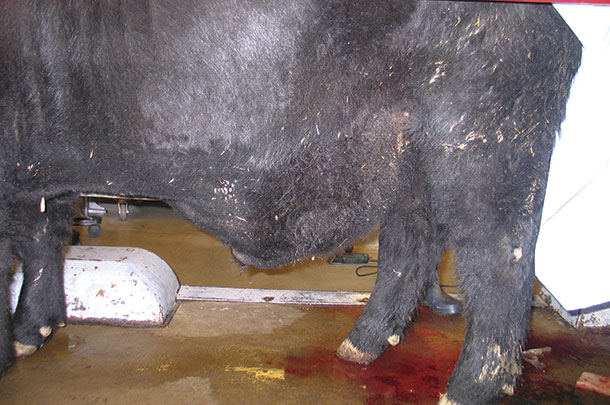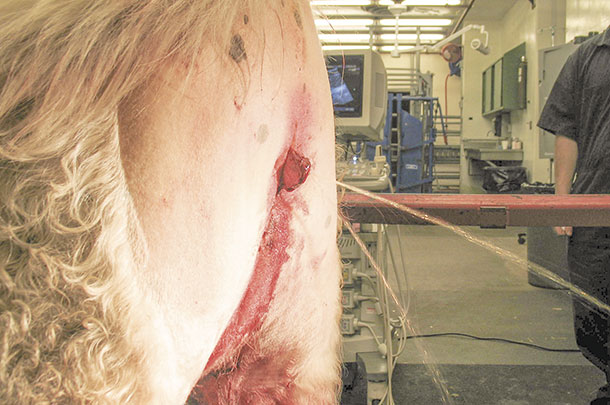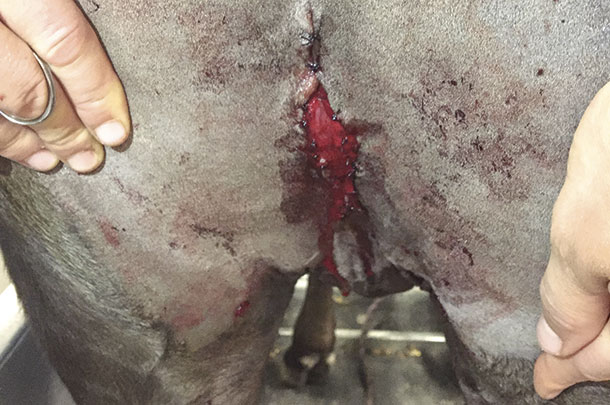Most cattle producers have encountered common livestock ailments such as foot rot and pinkeye, but more unusual health issues pop up from time to time that cause concern.
Bladder or urethra rupture (water belly)
Andrew Niehaus, professor of farm animal surgery at Ohio State University Veterinary Medical Center, says one condition affecting feedlot animals is often referred to as “water belly.” While the term has been broadly accepted, Niehaus explains there are two distinct but related conditions. Both can be caused by heavy-grain diets, high in phosphorus or by dehydration predisposing cattle to various types of urinary calculi (kidney or bladder stones). Early castration is also believed a slight factor, as the urethra of intact males continues to grow slightly larger than those of early castrated calves.
The first disorder is the “true” water belly and occurs mainly in males when the bladder ruptures. The urethra, the tube carrying fluid from the bladder to the penis, becomes completely obstructed and urine backs up into the bladder until it expands and eventually ruptures.
“If the bladder ruptures, it is a condition scientifically known as ‘uroabdomen,’ meaning the defect causes an accumulation of urine in the abdomen. The lay term is water belly,” Niehaus explains.

An animal is shown that has a urethral rupture and has accumulated a lot of urine in the tissues of his ventral abdomen. Photo courtesy of Andrew Niehaus.
The second disorder occurs when the urethra becomes blocked and breaks open, but the bladder remains intact. When this happens, urine gathers within the tissues on the ventral abdomen and sheath area. Swelling will occur, not as significant as an abdominal extension but will reach as high as the scrotum and as low as the front of the sheath area.
The prognosis for each of these problems varies depending on whether it’s a feedlot animal destined for slaughter or a breeding bull.

A steer urinates from hi PU site. Photo courtesy of Andrew Niehaus.
“First, both of these conditions can be fatal if not treated, but if we catch them early enough, before there is systemic compromise, we can save their lives,” says Niehaus.
Bladder ruptures are more repairable and tend to heal quickly on their own or with surgery in more severe cases. If the urethra is intact and additional blockages or stones can be dissolved or removed, breeding animals will often continue in their reproductive roles.
Urethral ruptures are a different story. The surgical repair is a procedure called a perineal urethrostomy (PU), which entails opening the urethra above the obstruction or rupture to provide urinary outflow. This works well for steers but not for breeding bulls requiring an intact urethra leading to the penis.

A picture of a steer with a perineal urethrostomy after surgery. Photo courtesy of Andrew Niehaus.
With successful PUs, they will “pee like a girl,” says Niehaus. After a few days of urine drainage, the kidneys will normally filter the remaining waste products, and they should be able to function through the finishing period.
Steers with serious bladder ruptures not healing on their own will likely not recover. PU procedures don’t repair the bladder, and prolonged urine leakage into the abdominal tissues will be absorbed into the bloodstream, causing death.
Physical signs of the two urinary complications are straining to urinate or appearing uncomfortable while pumping the tail. Small white granules collecting around the prepuce hairs indicate over-concentrated urine – a warning of crystals and stones forming.
Lump jaw
Another noticeable condition occasionally occurring in feedlot cattle is lump jaw. Geof Smith, professor of ruminant health and production medicine at North Carolina State University, says there are also two kinds of this health problem: soft tissue abscesses on the outside of the face and infections entering the jaw bones.
Often, they display as protrusions on the side of the face and, in advanced stages, become obvious.
Both types can be caused by either an internal mouth wound from chewing on stiff pieces of roughage, wires or sticks, or by an exterior wound from contacting something sharp such as a nail or branch.
Smith says the soft tissue abscesses can be treated easily by lancing, draining and flushing, followed by common antibiotics to control infection. If left untreated, the infection will continue, and the lump will grow until eventually it may break open and discharge a sticky fluid.
Contaminations reaching the inside of the bone are harder to eradicate. If too severe, teeth become loose and interfere with chewing.
The lump may stop growing, and the animal can be marketed before it enlarges again.
Rectal prolapse
Another ugly problem in feedlot steers is rectal prolapse. Tissues normally held inside the body are turned inside out and pushed outside. This usually occurs with cattle on high-concentrate rations or in very young calves with diarrhea, especially from coccidiosis.
Dan Thomson, department head of animal science at Iowa State University, says it’s difficult to pin down why they happen. “I don’t know if anyone really knows the etiology of rectal prolapse. Anything increasing straining to defecate can lead to it. Or piling on top of each other, but that is more often seen in pigs.”
He doesn’t believe genetics plays a role either. “I think it could be more of a mycotoxin or parasitic load situation increasing straining, combined with the potential for higher levels of abdominal fat decreasing the amount of room in the abdominal cavity.”
Often, steers will initially retract the tissue back inside the body but, over time, push it farther out until it becomes impossible to withdraw.
“We need to watch them closely, but if they can pull them in, we don’t fix them. If not, they might freeze, dry out, get sunburned or damaged by fences or being stepped on.” Sometimes, cattle are not able to defecate, leading to additional discomfort and excessive straining.
The prognosis is usually quite good, says Thomson. “We use umbilical tape and do a purse-string suture around the anus to hold them in. The swelling will go down and the straining will typically stop fairly soon.”
Each of these issues are dealt with in feedlots, sometimes being taken for granted. “Cases are unique, and every animal responds differently,” Thomson adds. “It’s critical to work with a veterinarian. They’re trained in this area and can be of help with disorders we don’t deal with day-to-day.”








